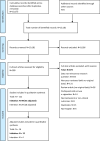A systematic review and meta-analysis of the association between e-cigarette use among non-tobacco users and initiating smoking of combustible cigarettes
- PMID: 38773514
- PMCID: PMC11110305
- DOI: 10.1186/s12954-024-01013-x
A systematic review and meta-analysis of the association between e-cigarette use among non-tobacco users and initiating smoking of combustible cigarettes
Abstract
Introduction: The rapid increase in e-cigarette use over the past decade has triggered an important public health question on the potential association between e-cigarette use and combustible cigarette smoking. Following AMSTAR 2 and PRISMA guidelines, this evidence synthesis sought to identify and characterize any associations between e-cigarette use among individuals not smoking cigarettes and initiation of cigarette smoking.
Methods: The protocol was registered on September 24, 2018 (PROSPERO 2018 CRD42018108540). Three databases were queried from January 01, 2007 to April 26, 2023. Search results were screened using the PICOS review method.
Results: Among 55 included studies (40 "good" and 15 "fair"; evidence grade: "high") that adjusted for gender, age, and race/ethnicity between groups, generally, there was a significant association between non-regular e-cigarette use and initiation of cigarette smoking, further supported by the meta-analytic results (AOR 3.71; 95% CI 2.86-4.81). However, smoking initiation was most often measured as ever/current cigarette smoking. Two studies (quality: 2 "good") evaluated progression to regular cigarette smoking among individuals with regular use of e-cigarettes, and generally found no significant associations. One study ("good") evaluated smoking initiation among individuals with regular use of e-cigarettes, finding an increasing probability of ever smoking cigarettes with increased e-cigarette use. Twelve studies (10 "good" and two "fair") examining progression to regular smoking among individuals with non-regular use of e-cigarettes reported inconsistent findings.
Conclusions: Numerous methodological flaws in the body of literature limit the generalizability of these results to all individuals who are not smoking cigarettes with few studies measuring established/regular use/smoking of e-cigarettes and cigarettes. Further, studies did not control adequately for specific confounding variables representing common liabilities between e-cigarette use and cigarette smoking, nor did they account for sufficient follow-up durations. Collectively, these flaws limit the generalizability of findings to the question of an association between e-cigarette use and cigarette smoking initiation.
Keywords: Cigarette smoking; E-cigarettes; Meta-anlaysis; Progression to smoking; Regular smoking; Smoking initiation.
© 2024. The Author(s).
Conflict of interest statement
Dr. Kim is a former full-time employee of RAI Services Company, a wholly owned subsidiary of Reynolds American Inc.
Figures






References
-
- NASEM . Public health consequences of e-cigarettes: a consensus study report of the National Academies of Sciences, Engineering, and Medicine. Washington: National Academies Press; 2018.
Publication types
MeSH terms
LinkOut - more resources
Full Text Sources
Miscellaneous

